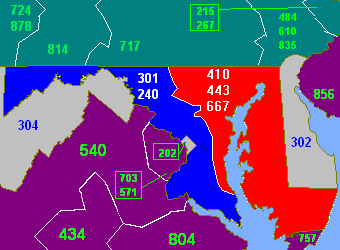Area codes 410, 443, and 667
Area codes 410, 443, and 667 are telephone area codes serving the eastern half of the U.S. state of Maryland, including the Baltimore metropolitan area and the Eastern Shore. The 410 area code is the original area code, while the 443 and 667 codes are overlay codes. 443 and 667 were primarily used with cell phones and CLEC carriers such as Comcast or Cavalier Telephone when introduced but have since become universal in their carrier availability.

History
Before these area codes were created, all of Maryland had been served by 301 since the institution of area codes in 1947, even though the state is home to two very large metropolitan areas—Baltimore and the Maryland suburbs of Washington, D.C. (area code 202). This made Maryland one of the most-populous states to be served by a single area code. However, by the late 1980s, 301 was on the verge of exhaustion due to the rapid growth of the Baltimore and Washington suburbs, as well as the proliferation of fax machines and pagers.
The number shortage problem was exacerbated by the use of 202 as a de facto overlay for the entire Washington metro area. Every number assigned on the Maryland side of the metro, as well as in northern Virginia's area code 703, was given a "hidden" number in 202, making it possible to complete a call within the metro area with only seven digits. One consequence of this was that a central office prefix could not be duplicated anywhere in the Washington area. Thus, if a 202-574 number was in use in the District or a 703-574 number was in use in northern Virginia, the corresponding 301-574 number could only be assigned to an area considered a safe distance from Washington, such as but not limited to in the Eastern Shore.
The partial overlay ended in 1990, but it soon became apparent that this would not free up enough numbers to meet demand. By the fall of 1990, it was apparent that there was no way to stave off the immediate need for a new area code in Maryland. In November 1990, a plan to add a second area code to the state was announced. It was decided that the Baltimore metropolitan area and the Eastern Shore would get the new area code, area code 410, while western and southern Maryland—including the Washington suburbs—would remain with the 301 area code.[1] The western half of the state retained 301 because the bulk of Maryland's population resides in the Washington suburbs. On the other side of the Potomac River, many of the same factors resulted in most of the old 703 territory outside of Northern Virginia split off as area code 540 in 1995.
Area code 410 officially entered service on October 6, 1991; it was initially implemented in permissive-dialing mode, not as a flash-cut, with the 10-digit dialing scheme coming in for local calls across the new 301/410 boundary. The split largely followed metro lines. However, parts of Anne Arundel, Carroll, Frederick, and Howard counties were split between area codes 301 and 410.[2][lower-alpha 1] Effective November 1, 1991, ten-digit dialing was required when calling a different area code in Maryland.[3]
Although the split was intended to be a long-term solution, within five years 410 was already close to exhaustion due to the proliferation of cell phones and pagers, particularly in and around Baltimore. To solve this problem, area code 443 was overlaid onto the 410 territory on July 1, 1997. Overlays were a new concept at the time, and had met resistance because of the requirement for ten-digit dialing. However, even with 410 on the verge of exhaustion, the Eastern Shore was not deemed large enough for implementing a separate numbering plan area. Bell Atlantic (now Verizon), the largest telephone provider in the region, wanted to spare residents the expense and burden of changing their numbers for the second time in a decade.
By 2011, the 410/443 area was once again running out of numbers because of the continued proliferation of cell phones. To spare residents another number change to a new area code, a third overlay code, area code 667, was implemented on March 24, 2012.[4] This had the effect of assigning 24 million numbers to just over four million people.
Coverage
The counties served by these area codes include:
Notes
- Four counties were split between area code 301 and 410.
- Anne Arundel County was assigned area code 410, except Laurel exchanges 210, 317, 490, 497, 498, 596, 604, 725, and 778 and Marlboro exchange 952 remained area code 301.
- Carroll County was assigned area code 410, except Mount Airy exchange 829 remained area code 301.
- Howard County was assigned area code 410, except Mount Airy exchange 829 and Laurel exchanges 210, 317, 490, 497, 598, 604, 725, and 776 remained area code 301.
- Frederick County remained area code 301, except Union Bridge exchange 775 and New Windsor exchange 635 was assigned 410.[2]
References
- "New area code coming". The Baltimore Sun. November 21, 1990. p. E6.
- "New area code for eastern Maryland". The Baltimore Sun. November 1, 1991. p. 1A.
- "Now Area Codes Count in Md." The Washington Post. November 2, 1992. p. B9.
- Fazeli Fard, Maggie (October 12, 2011). "Maryland's new 667 area code goes into effect in 2012". The Washington Post. Retrieved July 23, 2012.
External links
- NANPA area code map of Maryland
- List of cities covered and exchanges from Area-Codes.com, 410 Area Code
- List of cities covered and exchanges from Area-Codes.com, 443 Area Code
| Maryland area codes: 240/301, 410/443/667 | ||
|---|---|---|
| North: 717/223, 484/610 | ||
| West: 301/240 | area codes 410/443/667 | East: 302, Atlantic Ocean |
| South: 757/948 | ||
| Delaware area codes: 302 | ||
| Pennsylvania area codes: 215/267/445, 223/717, 272/570, 412, 484/610, 724, 814, 878 | ||
| Virginia area codes: 276, 434, 540, 571/703, 757/948, 804 | ||